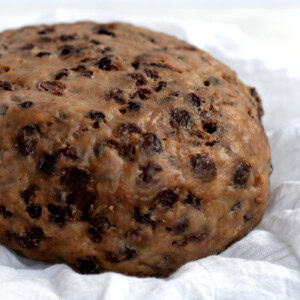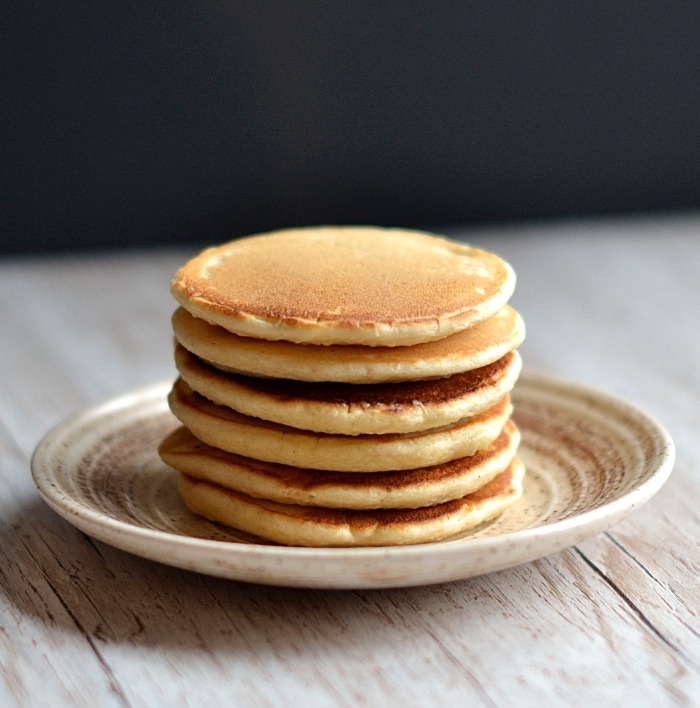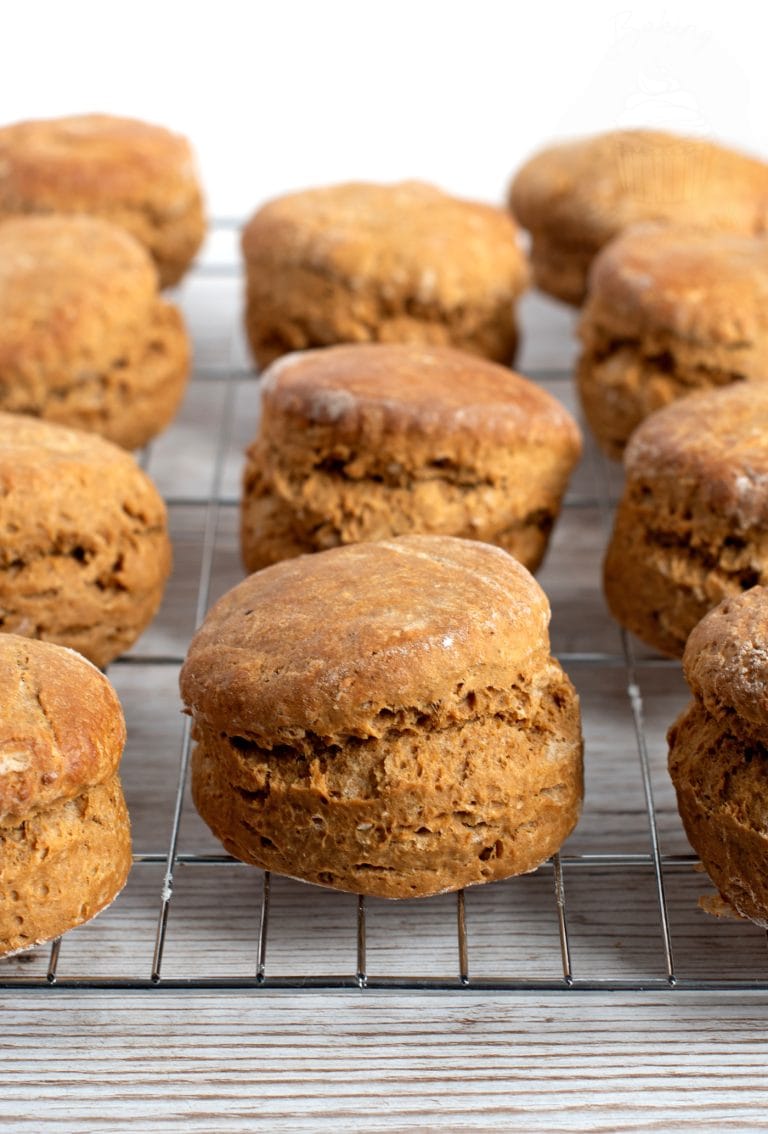Clootie Dumpling
A truly iconic Scottish dessert! Clootie Dumpling is a pudding like no other, with an interesting cooking method, which explains the name.

Let me start this Clootie Dumpling recipe by saying there is a lot of information here. A LOT.
That is an intentional decision. Despite being Scottish, Clootie Dumpling wasn’t something I even tasted until well into adulthood. And something I didn’t attempt to make until my mother-in-law recently shared her family recipe with me.
And boy, was this a learning curve! In theory, Clootie Dumpling is a fairly easy recipe. But as I soon found out, there are a few things that can easily go wrong or cause the panic of, “is that meant to happen?”, when you’ve never tried to make it before.
So, for you, I have tried to include: the history of Clootie Dumpling; in-depth instructions to keep your right; ingredient explanations & substitutions; and lots of tips for success. A complete, easy-to-follow, fool-proof, and authentic Clootie Dumpling recipe!
Like I say, Clootie Dumpling isn’t a recipe I had tried until I was an adult. In fact, the first time I tasted it was at Foodies Festival Christmas in Edinburgh in 2018, when the lovely Michelle of Clootie McToot joined us to demonstrate how to make your own Clootie Dumpling. Unfortunately, I missed the majority of her demo due to being backstage prepping for my own upcoming demo, straight afterwards. I did, however, steal a bowl of her delicious Clootie Dumpling, and it was love at first spoonful!
Since then, I have hoped and planned to share a Clootie Dumpling recipe on Baking with Granny, but we didn’t have one that had been passed down the generations, like so many of Granny’s other recipes. That’s when my wonderful mother-in-law stepped in to share her family’s Clootie Dumpling recipe.
It did not disappoint. Like all the very best family recipes, it came with measurements that I would have to decode somewhat – you know that “one teacup” is never going to be the same in grams twice, nor the same from ingredient to ingredient.
Once I had that figured out, it soon became apparent that this recipe made the mother of all Clootie Dumplings! It was HUGE. My mother-in-law did say that she remembered the men of the family enjoying the leftovers fried for their breakfast the next day, so I did wonder if the size was intentional to ensure plenty of leftovers! But for your average home baker who is baking for family, I decided to half the recipe. That and because it was nearly impossible to fit in any of my pots!
The only other tweak I have made to this recipe is in the amount of mixed spice. After halving the recipe, I found I was craving a little more of my favourite flavours, so I doubled up on the amount of mixed spice.
Otherwise, this recipe is the original family recipe that has been passed down through generations of one Scottish family. Just a little bit smaller, but still a very generous size!

Ingredients for Clootie Dumpling:
Self-raising Flour
Clootie Dumpling is a very dense pudding, but we still opt for self-raising flour. This gives it a little bit of lift, which is seen more in the fact that your dumpling “grows” as it cooks, as opposed to it becoming light and fluffy! The flour also helps bind everything together once the liquid is added to the mixture.
Caster Sugar
I opt for caster sugar because I like the sweetness it provides; however, you can use a golden caster sugar or a brown sugar if you’d prefer. The darker the sugar, the less sweet, richer and deeper in colour your clooty dumpling will be.
Suet
Suet is somewhat the secret ingredient in clootie dumpling recipes, which gives it the heavy, stodgy, stick-to-your-ribs texture which you would expect. Traditionally, it would be beef suet that is used, but much like with Jam Roly Poly, I’m not keen on the idea of beef being used in a sweet pudding. So I lean towards vegetable suet – but it’s purely personal preference.
Breadcrumbs
I’ve seen some recipes use oats instead of breadcrumbs, but for me, breadcrumbs are where it is at when it comes to Clootie Dumpling. You want to be using fresh breadcrumbs, as opposed to the dry, panko-style kind. I just pop a slice of bread into my food processor and there you go – fresh breadcrumbs! One slice of a standard white bread is about right in terms of quantity. You could use oats if that’s what you expect in a Clootie Dumpling, but I find breadcrumbs to be much more understated (in terms of taste & texture), to the point you don’t even realise they are there, allowing the fruit and spices to take centre stage.
Mixed Spice and Cinnamon
The ideal flavour combo to accompany dried fruits! My mother-in-law’s recipe for Clootie Dumpling did use a little less mixed spice and cinnamon, but after a bit of testing, I decided to up it marginally. That being said, Granny did point out that often in old family recipes, when they say “a teaspoon” of something, it probably wasn’t a level teaspoon measurement, and more likely a heaped teaspoon – and closer to the amounts this recipe actually states anyway.
Raisins & Currants
Staying true to the family recipe, I have listed the dried fruits as raisins and currants. However, like Christmas Cake & Black Bun, you can experiment and use whatever dried fruits you prefer. Currants are great because their size means they disperse in the mixture very well. But you can mix & match your dried fruits to whatever you have available, or whatever your family likes best.
Apple
An apple adds a little extra texture, flavour and moisture to your Clootie Dumpling. Again, it’s personal preference what kind of apple you use – I tend to just opt for whatever is in the fruit bowl! A smaller apple is best for this recipe, but you could always use half an apple if you can only get your hands on larger apples.
Treacle
Another ingredient that goes along perfectly with the dried fruits and spices. Treacle not only adds a bit of depth to the flavours – it also adds a little colour and serves like a sticky glue!
Milk
The addition of milk to your dry clootie dumpling mix will transform it into a sticky, raw dumpling, ready for its cloot! You want cold milk, straight from the fridge – the aim is to keep the suet in bits before it gets to cooking, and cold milk helps achieve this.
Traditionally, it would be a whole-fat dairy milk used in a clootie dumpling; however, you can use whatever milk you have available – it is quite a forgiving mix. I have even used soya milk, with great success!

Tips for the best Clootie Dumpling:
• When it comes to your “cloot” or cloth, the options are pretty much endless. I use a muslin square, purely because I wanted them to make these pretty Clootie Dumpling photos. But you can use any old [clean] muslin cloth, tea towel or piece of cotton fabric. I’ve even heard of people using old pillow cases!
• When it comes to your pot, you want depth over width, and a lid is a must. Whilst filling your pot with water, only fill it about half to two-thirds full. Once you add your dumpling, the water level will rise considerably. I usually keep a jug to hand and remove some of the water before adding my dumpling, then return the water to the pot once the dumpling is in. A hack I came up with after scalding myself with overflowing water during my first Clootie Dumpling attempt! Ouch.
• You place a small saucer in the pot of water to stop the dumpling from touching the bottom of the pot (the hottest area) and getting burnt. A saucer lifts it away and prevents this from happening. A saucer is the traditional method, but I actually tend to use the lid of a Pyrex casserole dish – it’s a little heavier and doesn’t rattle around quite as much.
• “Scalding” your cloot (ie. dipping it in the pot of boiling water) and dusting it with flour is an essential step – this is what forms the skin on your clootie dumpling. Don’t skip this! I find sifting the flour onto my damp cloot to be the most effective method for even distribution, but as long as you have a decent coating of flour, you’ll be grand. And you can tip/gently shake any excess flour into your bin or sink.
• You can simply tie your cloot with a piece of string and be done with it, but I find there is a method of tying that makes your Clootie Dumpling experience far more enjoyable… You take your length of string (about half a metre), and fold it in half. You then take the looped end of the string and use this to tie around your cloot, feeding the string through the loop, before tying the ends around and securing with a small knot. Next, you tie the loose ends of the string and drape this out of the pot, securing around your pot handles or lid – this helps stop your dumpling from dancing around the pot too much, as well as making the removal of the dumpling so much easier.
• The saucer at the bottom of your pot will dance around, usually making a lot of noise. Don’t worry! This is normal, but it doesn’t seem to be mentioned in most Clootie Dumpling recipes – no need to panic.
• Your dumpling may float whilst cooking. Again, this is normal but doesn’t seem to be mentioned in most Clootie Dumpling recipes. As long as there is enough water to cover your dumpling while fully immersed, it will be fine. You may need to top up with boiling water periodically as it evaporates. But don’t be concerned if it is floating – the movement, as well as the heat being kept in by the lid, will ensure the top (bottom?) of your dumpling is cooked, despite it seemingly trying to escape!
• Take your time removing the cloot – you don’t want to rip the skin off because you’re worried about burning your fingers! Start by removing it from the bottom and sides. Then use a plate to flip your dumpling, before removing the cloot from the top. Then gently flip it back onto its bottom, on top of a baking tray, ready to finish in the oven.


Clootie Dumpling
EQUIPMENT
- Small Saucer (to sit at the bottom of your pot)
- Muslin Cloth (or similar)
- String or Twine (ensure it's food-safe)
- Baking Tray
INGREDIENTS
- 250 g Self-raising Flour (plus extra for dusting)
- 75 g Caster Sugar (Superfine Sugar)
- 50 g Suet (vegetable or beef)
- 30 g Breadcrumbs (fresh)
- 1 tsp Mixed Spice (Pumpkin Spice)
- 1/2 tsp Ground Cinnamon
- 170 g Raisins
- 120 g Currants
- 1 small Apple (peeled & grated)
- 1/2 tbsp Treacle (Molasses)
- 280 ml Milk (cold)
INSTRUCTIONS
- Place your saucer at the bottom of your pot and fill about half too two-thirds full of water. Set to boil, whilst you prepare your clootie dumpling.
- In a large bowl, add all the dry ingredients and the grated apple. Mix well until combined. Add the treacle and milk. Mix well until combined, and you have a sticky mixture. Set aside whilst you prepare your cloot (cloth).
- Take your cloot and dip it in your now-boiling water. Carefully remove the cloot with tongs and set it down to cool a little. Once cool enough to handle (but still warm), squeeze out the excess water, before laying your cloot onto a flat work surface. Sift a little extra flour over the top. You don't need flour from edge-edge/corner-corner but make sure the majority of your cloot is coated. Gently shake off the excess flour.
- Turn your dumpling mixture into the middle of your flour coated cloot, using your hands to shape it into a rough round shape. Take the corners of your cloot and pull them together, gathering the edges in too, making sure there's no gaps. Be careful not to pull your dumpling in too tight – you want to leave a little space for your dumpling to swell as it cooks. Tie your cloot with your string (see Granny's Top Tips for advice on how to do this efficiently).
- Place your dumpling into your pre-boiled pot of water, ensuring the entire dumpling is covered in water (top up with more boiling water if not). Reduce the temperature to a simmer and place the lid on your pot. Allow to simmer for 3 – 3½ hours. Keep an eye on your pot and top up with boiling water whenever the water is creeping below your dumpling.
- After 3 – 3½ hours, remove your dumpling from the pot and pop it onto your tray to cool for a short while, before removing the cloot. Be careful of your fingers because it will still be hot! Cut the string around your cloot and remove. Gently peel back the cloot from the dumpling, being careful not to peel off the skin too. Once you have peeled the cloot from the top and sides of the dumpling, use a plate to flip the dumpling and remove the cloot from the bottom, before returning it back to the baking tray, right-side up.
- Pre-heat your oven to 180°c (160°c for fan-assisted oven, Gas Mark 4 or 350°F) Allow your cloot to air-dry whilst your oven pre-heats and then place into your oven for about 20-30 mins, until the skin darkens and looks dry & shiny.
- Remove from the oven and allow to cool a little before serving in wedges, with custard or cream.
IMPORTANT NOTE:
All my recipes are developed using a digital scale and the metric system (grams and millilitres). Cup measurements are available as a conversion but these, unfortunately, won’t always be as accurate. For best results, I always recommend baking with a digital scale.
RECIPE NOTES:
- For full ingredient explanations, including substitutes, please see the Ingredients information above.
- For all our tips in achieving an authentic Clootie Dumpling, please see Granny’s Top Tips above.
- For ways to make this a vegan Clootie Dumpling, see the Free-from & Vegan hacks below.
- Clootie Dumpling can be kept in an air-tight container, in the fridge for up to one week. It can be eaten cold but is best enjoyed when warmed up before serving (either in the microwave, or in the oven wrapped in tin foil).
- Clootie Dumpling can be frozen for up to 6 months. For ease, cut it into wedges, wrap well in clingfilm/tinfoil, and freeze individually. Defrost before serving. Again, it is fine to eat cold but best enjoyed when warmed up (either in the microwave, or in the oven wrapped in tin foil).
Clootie Dumpling is a traditional Scottish pudding, comparable to Christmas Pudding but unique in its own way. The dumpling itself is made up mostly of dried fruits, such as raisins & currants, as well as flour, breadcrumbs, sugar, suet, and milk, along with a few other flavourful ingredients.
What makes Clootie Dumpling unique is the method in which it is cooked, which is also where it gets its name. Clootie Dumpling is boiled in a cloth, which in Scotland is also known as a “cloot”. The method also helps achieve the unique texture that Clootie Dumpling is known and loved for.
To make an authentic Clootie Dumpling, you start by mixing your dried ingredients together, before adding your wet ingredients, and mixing to create a thick, sticky dumpling mix.
You then take your “cloot” (cloth), scald it in hot water, before squeezing out the excess water & dusting it with flour. It’s this vital step that creates the skin on your Clootie Dumpling. Next, you spoon your dumpling mixture into the cloth, before tying up the corners and edges, and then boiling your Clootie Dumpling for around 3 hours.
Once the boiling time is done, you take your dumpling out of the water, carefully remove the cloot, before popping your dumpling into the oven to dry out the skin. Historically, you would dry it out beside the fire, but I find an oven to be a bit more agreeable with modern life!
Finally, you can serve your Clootie Dumpling warm, with some custard, fresh cream, or a scoop of ice cream. Or, fry it in slices the next day and have it for breakfast.
Clootie Dumpling keeps very well, due to the high content of dried fruit. Keep any leftovers in an air-tight container in the fridge, where they will be good for a week. Any longer, cut your dumpling into wedges and freeze them individually – it will be good in the freezer for up to 6 months.
Clootie Dumpling can be eaten cold but is best enjoyed whilst warmed up again (in the microwave, or wrapped in foil in the oven).
Free-from & Vegan:
Gluten-free: I haven’t tried making a gluten-free Clootie Dumpling, but in theory, it should be as easy as using gluten-free self-raising flour, gluten-free suet and gluten-free breadcrumbs. If you do try this recipe for gluten-free Clootie Dumpling, let me know how you get on!
Nut-free: This Clootie Dumpling recipe doesn’t contain any nuts, but be sure to double-check your individual ingredients for allergens.
Egg-free: This is an egg-free Clootie Dumpling recipe. But be sure to double-check your individual ingredients for allergens when making for someone with an egg allergy.
Dairy-free: To make this a dairy-free Clootie Dumpling recipe, simply use your favourite milk alternative. I have used soya milk with great success, but I think any plant milk should work.
Vegan: To make this a vegan Clootie Dumpling recipe, simply use a vegetable suet and your favourite milk alternative. I have used soya milk with great success, but I think any plant milk should work.
N.B. Any advice or suggestions to make recipes “free-from” or vegan are purely that – suggestions. Please be careful to double-check all ingredients individually, taking extra caution when serving to those with allergies & intolerances.
For more info on common food allergies, please see food.gov.uk | For more info on coeliac disease, please see coeliac.org.uk | For more info on a vegan diet, please see vegansociety.com







I’ve made this recipe twice and each result came out amazing.
My last one, I ran out of treacle so I substituted the remainder with golden syrup and it worked great.
Might not have had the same dark colour but the entire family loved it.
How long would you need to. Cook the dumpling if the quantity was doubled?
How can you tell when it is cooked?
We never put in oven to dry just dry naturally ordinary sugar was used and a tight fitting lid keep the duff we called it covered in boiling water can take up to 4 hours depending on amount delicious cold as well for breakfast with fried egg just reheat in microwave for less than a minute .
My wife’s granny used to add a grated CARROT to the recipe…yes, you read that right carrot! Trust me, you will not be disappointed!
I made one with my sister-in-law on Hogmanay (it’s starting to turn into a tradition now!) and it was a beast of a thing. Turned out great and everyone was raving that it was our best one-yet! I wish I could upload the photos. I have fond memories of helping my late mother make them as a child.
That a great tip from Caroline on turning the plate in the saucepan upside down to stop it rattling-thanks!
Has anyone tried using a pressure cooker to make this pudding. . ? And I expect it still has to be in ‘cootie’ tied leaving ,a bit of expansion space.?
Pressure cooking ,using lot less water and time ?
I hope it’s possible.